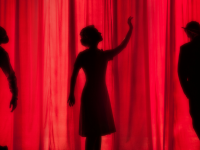Being neurodivergent often means walking into the world with misunderstanding as a certainty. Everyone expects you to respect and abide by rules unstated and unknown to you. As an autistic person, larp has brought me places where the rules are shared and I can have the same language as others. And for someone who didn’t have a voice for so long, being able to communicate, feel, and create with others is more than just a little magic.
Through a series of testimonies illustrated by drawings we hope to raise awareness and bring acceptance in our larp communities on the difficulties encountered by the neurodivergent players both in life and in play. Here we have chosen to focus on people who have been diagnosed with ASD and/or ADHD.
While all neurodivergent experiences are different, you might find these testimonies are quite similar to each other. These correspondences demonstrate our deep similarities, the needs and traits that must be highlighted for neurotypical players and organizers to reach understanding and recognition of their neurodivergent counterparts. I’m also aware that those testimonies are personal statements that don’t account for all of neurodivergent players’ ways to relate and feel toward the larp experience.
What is the core of the neurodivergent players’s experience of larp?
What can we learn from each other?
What can we teach to neurotypical players and organizers?
What do we need from them?

Finding Magic in the Dark
LolV Peregrin
The autism spectrum encompasses a range of neurodevelopmental conditions, generally known as autism spectrum disorders (ASD). Individuals on the autistic spectrum experience difficulties with social communication and interaction and also exhibit restricted, repetitive patterns of behavior, interests, or activities.
–Wikipedia, “Autism Spectrum”
I grew up difficult. I was a difficult child and a difficult teenager.
The world was a maze. I felt I was the only one without a map.
Everyone seems to have figured their way out.
So I built my own world, full of all the things I liked.
I had an interest in magic, spells, witches. A specific one.
I’ve been labeled unhinged and crazy.
Because
I thought animals were better than people,
I walked bare feets,
My face was strange,
Because I looked for magic.
I felt too much, or not enough.
I am autistic, not a puzzle, therefore I can’t fit or be solved.
I hate unpredictability,
I wanted to be in control somehow, to understand what was happening.
To switch the narrative.
To find magic, dreamt and remembered.
My strong emotions,
my intense personality,
my ability to mask and interpret roles constantly:
It made larp the perfect environment for me.
A place where while we all wear masks I could finally forsake mine.
Role-play and Larp have brought me places where the rules are shared
and I can have the same language as others. Finally.
And for someone who didn’t have a voice for so long, being able to communicate, feel
and create with others is more than just a little magic.

My ADHD
Charlie Haldén
I instantly think of how my ADHD partly turns into something that makes me great at larping — that larp is a world that my brain is perfectly suited to (in ways), and how that is magic. My impulsive traits, spontaneity, the superpower of being totally in the moment – stuff that can make life outside difficult but fits perfectly with larp.
Always Playing a Role
Lea Elias
Many people on the autism spectrum feel obliged to pretend not to have autism. They invest considerable effort daily in monitoring and modifying their behavior to conform to conventions of non-autistic social behavior. This phenomenon has come to be called masking, compensation and pretending to be normal. Masking is exactly what it sounds like, simply putting on a metaphorical mask. In many cases of the autism spectrum, that mask is a neurotypical (“normal”) one. It is when someone on the spectrum either consciously or subconsciously hides the telltale signs they are on the autism spectrum.
— Bahar Ateş, “Masking in Autism: Social Camouflaging”[1]Ateş, Bahar, “Masking in Autism: Social Camouflaging,” Good Autism School, last retrieved April 17. 2021 from https://goodautismschool.com/autism-masking/

As an autistic person, I am, in a way, always playing a role.
It’s an experience not unique to people on the autism spectrum, but I’ve never met a neurotypical person who understood just how tiring it is to be born into a world where the way you express yourself is completely nonsensical to other people.
And vice versa, that the way other people express themselves, through tone, body language, and facial expressions, makes no sense to you, while pretty much everyone else appears to have an instinctual understanding of what the hell is going on.
To survive in that world, you need to become very adept at studying and copying the behavior of other people. In order to appear acceptable, I’ve developed into a chameleon; In seconds I can change my tone of voice, sense of humor, dialect, mannerisms et cetera.
While tiring in my day-to-day life, it’s proved very useful in larps, and I’ll often joke that the main difference between real life and larp is for me that having a character sheet makes the process of figuring out what role I’m expected to play much simpler.

Many Differences…
Cecilia Dolk
There are many differences between people that are on the spectrum, just as we are all different human beings. What is a struggle for me can be something that another person the spectrum has no problem with – at all.
As a producer and being diagnosed as an adult with both ADHD and autism, I finally can understand why some parts of producing feels natural and easy for me. It also makes so much more sense why I feel so much more comfortable visiting and participating in a larp and then going to a dinner party, birthday party, or just traveling to a new place.
Why, you may wonder?
The rules and expectations are equal within a larp since I don’t have an autopilot when it comes to social rules or boundaries, a larp setting – before – during, and after – is giving me the opportunity to participate on the same starting point as a person that is not on the spectrum.

Photo by Rebecca Burgess of Autism Spectrum.
To explain how my mind may be a bit different than yours, I don’t think in words, I think in pictures. My mind is like “google for images” and I attend to details – I mean all the details. Let me give you an example – If someone asks you to think of a shoe, your mind thinks of a generic one. Instead, my mind thinks of specific ones, one at a time or as a video that shows stuff on YouTube.
When it comes to new information and making decisions, my mind is like an international airport but I don’t have a staff running it. I have to manually do everything on my own, while for most other people it’s on autopilot. This happens so quickly in my mind and it makes me exhausted quickly and suddenly sometimes when I’m in a new situation.
I also feel sounds, I feel structures, but it isn’t scary or uncomfortable it can just be too much.
So, now you know a little bit of how my mind works, and many of these traits make me a kick ass as a producer – mostly because I remember details and not making assumptions on things. I run all different versions of the outcomes in my mind while I even may be talking to someone!
I can see and feel a budget work or not in my mind, logistics, and timetables – it’s like it’s there on my own internal whiteboard.

There is something that you can help your fellow larper with if they are on the spectrum, this is things that help everyone but for me, it’s the thing that decides on how much energy I will have during the larp. These things are often the difference for me on how much I can participate until I’m crashing and need to rest.
- Clear schedules – with times and what will happen during that time.
- Clear expectations – what do I need to do and when.
- Pictures and signs – an emoji next to a text can help our minds so much!
- Knowledge beforehand – show pictures of the venue and describe where I will have my sleeping quarters.
Also — sometimes it’s more comfortable being NPCs just because we get a clear picture of the run time schedule! Take that in consideration if you can offer that to some people before the game
- A place to recharge if the sleeping quarters are being in-game at all times.
- A clear structure of the website and if there is much information to read, it’s not a bad thing to have someone do an audio recording or be there to read it with a person. I know it’s much to ask – but maybe a volunteer can help with that and make it accessible for more people to join.
- Friendly reminders – if you have a deadline coming up and ask if they need any help!
- Be clear with changes before, during, and after, over explain is better than vague.
- Arrange someone in the coordination staff that can be a safe person and/or a person to ask questions that is focused to help people on the spectrum. It’s helped me tremendously to have someone that understands since the stigma and misunderstanding are making us mask and try to fit in.
- Ask – ask – ask. Ask us if you can do something to help, but also be clear that we may say “no”.If you do not have knowledge of how to adapt and create more accessible – ask for help – we will be so grateful to contribute knowledge that we have to create a better experience for us all.
Bibliography
Ateş, Bahar, “Masking in Autism: Social Camouflaging.” Good Autism School. Last retrieved April 17, 2021.
Wikipedia. “Autism Spectrum.” Last retrieved February 21, 2021.
References
| ↑1 | Ateş, Bahar, “Masking in Autism: Social Camouflaging,” Good Autism School, last retrieved April 17. 2021 from https://goodautismschool.com/autism-masking/ |
|---|






